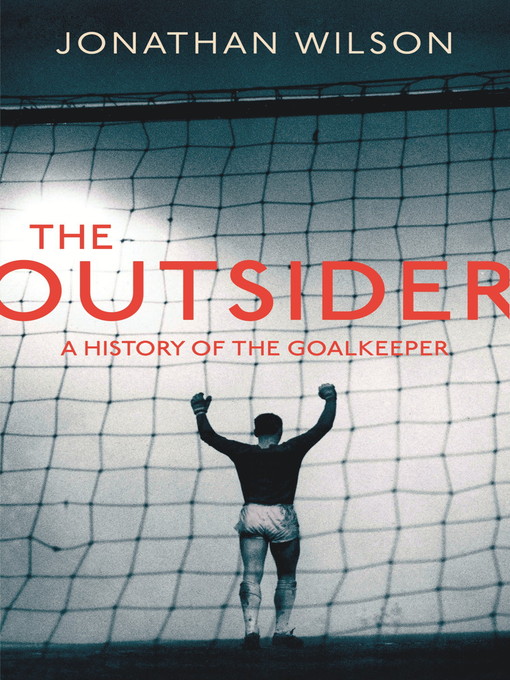Marcus Hahnemann sits alongside Peter Handke. Albert Camus is sandwiched by Jorge Campos and Santiago Canizares. And Friedrich Nietzsche has Thomas Nkono for company.
A scan of the index to Jonathan Wilson’s The Outsider: A History of the Goalkeeper – as well as a decent knowledge of obscure footballers and the most existential of literature – will confirm certain suspicions aroused by the book’s title: namely, ‘this is likely to be no ordinary sporting book’ and ‘this could go one of two ways’.
Wilson runs near the front of a group of unashamedly-intellectual football-writers. This is a breed that stands opposed to the type of mainstream reporting and punditry that revolves around unenlightening discussions of ‘talking points’ and lame descriptions of what we already know.
Wilson’s Inverting the Pyramid was a brilliant history of football formations and tactics – a topic that continues to be well explored at Zonal Marking. The Blizzard, which Wilson edits, is a wonderful journal showcasing the most wilfully-esoteric, the most wilfully-literary and, let’s say it, the most wilfully-pretentious football writing currently around. Goals are over-rated, goes one of the group’s catchphrases.
Thankfully, with The Outsider, Wilson stays well on the safe side of intellectualism for intellectualism’s sake. In fact, this book is a much straighter read than you might imagine. It proves to be compelling stuff for the curious-of-mind football-obsessive, if not, thankfully, for the pseud.

by Jonathan Wilson
351pp, Orion Books, £20
Wilson tells us that this ‘is a book about goalkeepers and goalkeeping….and how goalkeepers are represented culturally. ’ His thesis being that goalkeepers are a particularly interesting lot: the individuals, the awkward, the gloomy, the thinkers, the introverts, the ‘El Loco’-types of South America, the funk-sticks (as H.C Benham wonderfully, if disgracefully, calls them in his book on a Victorian form of The Beautiful Game). As Wilson acknowledges, this notion is perhaps more social construct than hard fact, but it still provides a way of exploring football’s histories and cultures – in fact, it’s likely to be a more useful way because of it.
By keepers, Wilson largely means the great and the good of those that have been paid to wear a number 1 shirt. Little time is given to those between the sticks on their lunchtimes or their Sunday mornings. We get a few pages on each of the likes of Banks, Felix, Fatty Foulkes and Buffon, with some personal history, analysis of style and trivia on each. So, for example, we find out that Dino Zoff played every single league game for eleven years, with a play called Perseverare humanum est being written about his understudy. We find out about how a dance teacher taught Peter Shilton more about balance and movement than any ex-pro (the usual old-boy network of coaches) could have done. We hear the sad tale of Barbosa, the brilliant goalie who is most famous for his mistake in the 1950 World Cup Final (recordings of which are like the Zapruder film for Brazilians). And, of course, we read about how Peter Schmeichel’s background in handball led him to develop his famous ‘star’ position when facing shots from point-blank range.
The Black Panther, the great Lev Yashin, gets a full chapter. That’s because there’s plenty to say about arguably the best of the best and his country’s love of goalkeeping – Russia being a place where the ‘gallant art has always been surrounded with a halo of singular glamour. Aloof, solitary, impassive, the crack goalie is followed in the streets by entranced little boys’, as a former goalkeeper by the name of Vladimir Nabokov eloquently put it.
In his run through number 1s, Wilson often sets up two goalkeepers for comparison, allowing him to indulge in his specialism of football tactics. So we read about tidy and reactive keepers, like Peter Shilton (stays in his box, commands it, reacts to shots, the perfect safe) versus unorthodox and proactive keepers, like ‘The Clown’ Jan Tomaszewski (happy out of his box sweeping up play, more likely to punch, gets in the way, makes the odd obvious mistake, stops attacks at source).
Wilson shows how this polarisation developed throughout history and, of course, took on a twist with the introduction of the backpass rule. Welsh goalie Leigh Richmond Roose caused consternation in the early 20th century with his sorties upfield. Wilson sees the infamous England 3 Hungary 6 game of 1953 as ‘arguably the most significant game in English football history’. Here he’s particularly interested in the role of Hungary’s goalkeeper Gyula Grosics, who was ‘unorthodox but effective’ (as the unsure Kenneth Wolstenholme said), and who ‘never hesitated to dash out of his penalty area, thus frequently becoming the extra full back. Since his timing was generally shrewd, the effect was to decrease to some extent the burden placed on the rest of the defence by the advanced position of the inside forwards’ (as the more certain, and less laconic, Brian Glanville noted).
The Liverpool teams of the 1960s and the Ajax teams of the 1970s are held up as examples as those who played with the keeper high up the pitch, liable to make the occasional blunder, but stopping, and even creating, more chances by playing that way. The Cameroonian goalkeeping battle between Thomas Nkono and Joseph-Antoine Bell (a man who, like Shilton, insists his best performances were those in which he organised his defence so well he didn’t have to make saves) is also used to play out the argument between different styles of keepers, and highlights Wilson’s expertise in matters away from European shores.
Many of the book’s most literary references are saved for the final chapter. Peter Handke’s The Goalie’s Anxiety at the Penalty Kick serves as an introduction to some ruminations on the 12yard shot – that perfect test of skill and bluff under pressure that is so often bizarrely described as a lottery when a game comes to a shoot-out.
After Handke’s novel (and the Wim Wenders film based on it), we take in Duffy, the detective and Sunday league keeper from the novels written by Julian Barnes under the name of Dan Kavanagh. We also find out about literary notables that played in goal, such as Evelyn Waugh, Yevgeny Yevtushenko, Arthur Conan Doyle and, of course, Albert Camus.
Towards the very end, Wilson reflects on the short story ‘No Ultimo Minuto’, by Brazilian writer Sergio Sant’Anna, which follows a goalkeeper who obsessively watches replays of a critical mistake. A mistake similar to the one Ronnie Blake has nightmares about in Brian Glanville’s novel Goalkeepers are Different – a title that would have worked well on the cover of Wilson’s book.
Certainly, as Wilson says, it would seem that on the rare occasions literature considers football, it concerns itself disproportionately with goalkeepers. Is that because it’s true that they are a more complex type than others? ‘What a load of cock!’, you might think, and as Graham Joyce says about the idea in his manual Simple Goalkeeping Made Spectacular. But, certainly, the lonely-looking appearance of the goalkeeper, as well as the do or die-ness of his art, does lend itself to a good story, as Wilson’s effort proves in spades.











